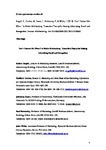Don't Distract Me When I'm Media Multitasking: Toward a Theory for Raising Advertising Recall and Recognition
| dc.contributor.author | Angell, R | |
| dc.contributor.author | Gorton, M | |
| dc.contributor.author | Sauer, J | |
| dc.contributor.author | Bottomley, P | |
| dc.contributor.author | White, John | |
| dc.date.accessioned | 2016-04-06T20:52:22Z | |
| dc.date.available | 2016-04-06T20:52:22Z | |
| dc.date.issued | 2016-02-04 | |
| dc.identifier.issn | 0091-3367 | |
| dc.identifier.issn | 1557-7805 | |
| dc.identifier.uri | http://hdl.handle.net/10026.1/4478 | |
| dc.description.abstract |
Media multitasking, such as using handheld devices like smartphones and tablets while watching TV, has become prevalent, but its effect on the recall and recognition of advertising has been the subject of limited academic research. We contend that the context in which multitasking takes place affects consumer memory for advertising delivered via the primary activity (e.g., watching television). Specifically, we identify the importance of the degree of (a) congruence between the primary and second screen activity and (b) social accountability of second-screen activities. We test our typology empirically by examining the determinants of next-day recall and recognition for billboard advertisers (perimeter board advertisements) of a televised soccer match. In line with our theory, in most cases media multitasking leads to worse recall and recognition. However, in situations where there is congruence between primary- and second-screen activities, and secondary activities have a higher level of social accountability attached to them, advertising recall and recognition improves. | |
| dc.format.extent | 198-210 | |
| dc.language | en | |
| dc.language.iso | en | |
| dc.publisher | Informa UK Limited | |
| dc.title | Don't Distract Me When I'm Media Multitasking: Toward a Theory for Raising Advertising Recall and Recognition | |
| dc.type | journal-article | |
| dc.type | Journal Article | |
| plymouth.author-url | http://gateway.webofknowledge.com/gateway/Gateway.cgi?GWVersion=2&SrcApp=PARTNER_APP&SrcAuth=LinksAMR&KeyUT=WOS:000373624400004&DestLinkType=FullRecord&DestApp=ALL_WOS&UsrCustomerID=11bb513d99f797142bcfeffcc58ea008 | |
| plymouth.issue | 2 | |
| plymouth.volume | 45 | |
| plymouth.publication-status | Published | |
| plymouth.journal | JOURNAL OF ADVERTISING | |
| dc.identifier.doi | 10.1080/00913367.2015.1130665 | |
| plymouth.organisational-group | /Plymouth | |
| plymouth.organisational-group | /Plymouth/Faculty of Arts, Humanities and Business | |
| plymouth.organisational-group | /Plymouth/Faculty of Arts, Humanities and Business/Plymouth Business School | |
| plymouth.organisational-group | /Plymouth/REF 2021 Researchers by UoA | |
| plymouth.organisational-group | /Plymouth/REF 2021 Researchers by UoA/UoA17 Business and Management Studies | |
| plymouth.organisational-group | /Plymouth/Users by role | |
| plymouth.organisational-group | /Plymouth/Users by role/Academics | |
| dcterms.dateAccepted | 2015-11-01 | |
| dc.rights.embargodate | 2017-8-4 | |
| dc.identifier.eissn | 1557-7805 | |
| dc.rights.embargoperiod | Not known | |
| rioxxterms.versionofrecord | 10.1080/00913367.2015.1130665 | |
| rioxxterms.licenseref.uri | http://www.rioxx.net/licenses/all-rights-reserved | |
| rioxxterms.licenseref.startdate | 2016-02-04 | |
| rioxxterms.type | Journal Article/Review |


